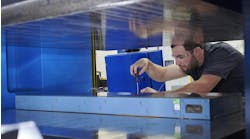An automation and manufacturing renaissance is taking root in the U.S. It’s only recently we’ve woken up and realized America can’t be a world leader just servicing goods made elsewhere. We need to actually make things in this country.
Traditionally, major manufacturers were vertically integrated, with in-house engineering experts in areas like hydraulics. But we’ve had a couple recessions, and consolidation in many industries is creating bigger, public companies keenly focused on the bottom line. When times are tough, they downsize and lose experienced and talented people. And when times improve, they tend not to bring them back.So here we are, teetering on the brink of a rebirth of American manufacturing, and OEMs no longer have the skill sets necessary to create the next generation of automation. This is where today’s high-tech integrators are stepping up.
Many integrators have strong legacies in fluid power. They’re often privately held, with lots of knowledge and automation expertise. They tend to be small to midsize regional companies that got better by partnering with smaller and experimental OEMs, or recognized opportunities that differentiated themselves from the pack. They’re dedicated, hardworking, and often a bit crazy — because being privately held lets them do things that public companies would never consider. Around the country they’ve developed a strong set of competencies, niches, and differentiators with core teams of engineers and software designers. They are also resilient, and they stick around. Price Engineering, for example, has been in business for 60 years. We have skills that can be difficult to find in today’s OEMs.
That’s not to say integrators don’t face challenges. For instance, we need to sell our value and not give away the engineering to move products. To fill the ranks of our engineering and design teams, we have to recruit from new sources, create training programs within our organizations, and develop educational partnerships.
Integrators need to acquire skills in areas like CFD, mathematical modeling, and simulation, and embrace concurrent engineering to complete projects faster. Finally, projects are getting more complex, involving multiple engineering disciplines. That demands better project management skills, and possibly new processes, people, and strategies in how we become professional engineering services entities.
Across the country, companies are emerging that have mastered the integration of fluid power with different technologies for advanced power transmission and motion control. Manufacturers and OEMs are just beginning to realize the value integrators offer. The next five years will be interesting as the dynamic evolution unfolds.
Tom Price is President of Price Engineering, a fluid power distributor and systems integrator based in Hartland, Wis. Visit the website at www.priceeng.com.


